Racism's Impact on Native American Health: A Social Determinant
VerifiedAdded on 2023/06/11
|12
|3543
|382
Essay
AI Summary
This essay examines racism as a significant social determinant of health affecting Native American communities in the United States. It discusses how racism manifests in unequal access to quality education, limited employment opportunities, and the uneven distribution of healthcare facilities, all of which contribute to health disparities. The essay highlights that racism interacts with other determinants of health, such as income and social class, to create systemic disadvantages. Furthermore, the essay outlines current efforts by the government, including health policies and legislation, aimed at addressing racism and promoting health equity for racially disadvantaged populations. Desklib provides access to similar essays and study tools to further explore this topic.
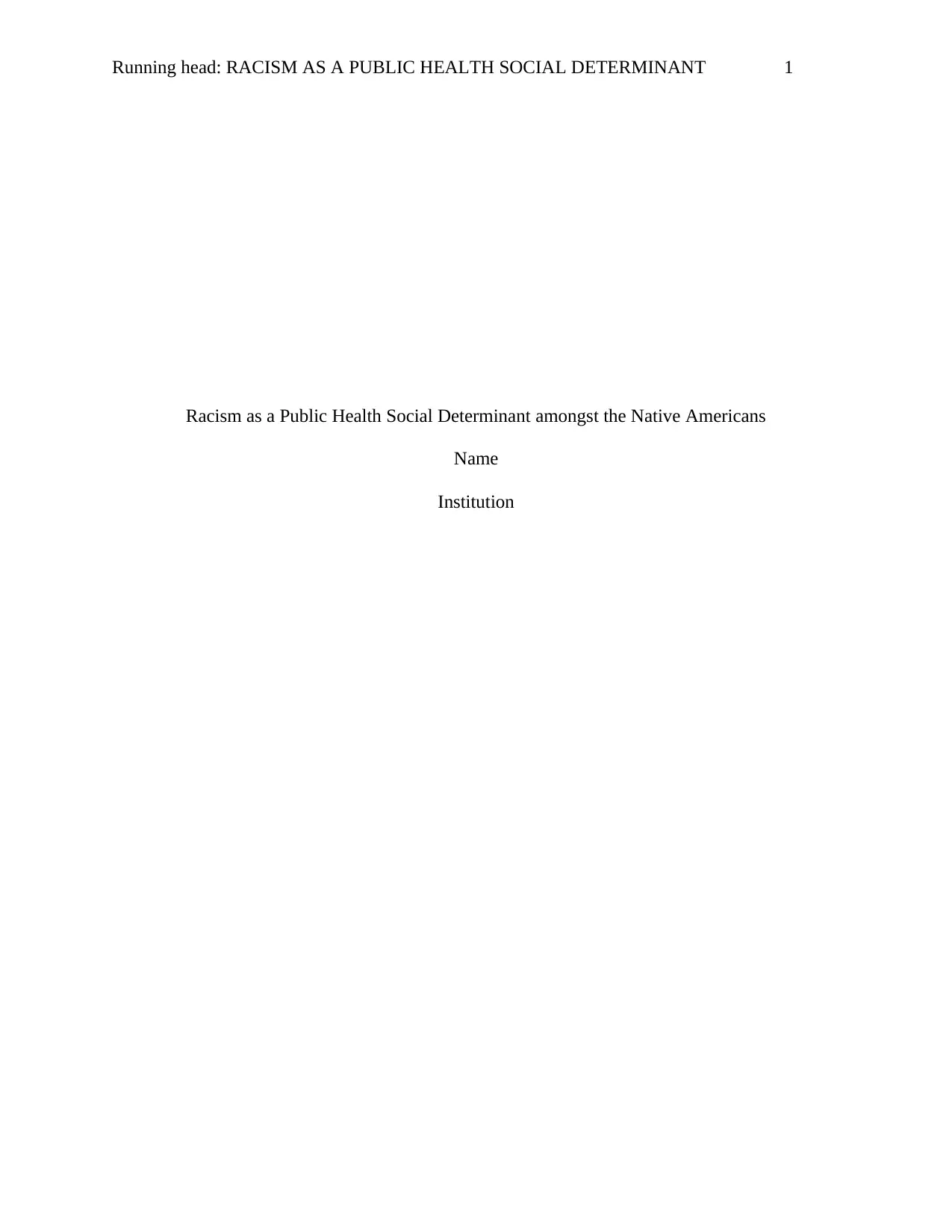
Running head: RACISM AS A PUBLIC HEALTH SOCIAL DETERMINANT 1
Racism as a Public Health Social Determinant amongst the Native Americans
Name
Institution
Racism as a Public Health Social Determinant amongst the Native Americans
Name
Institution
Paraphrase This Document
Need a fresh take? Get an instant paraphrase of this document with our AI Paraphraser
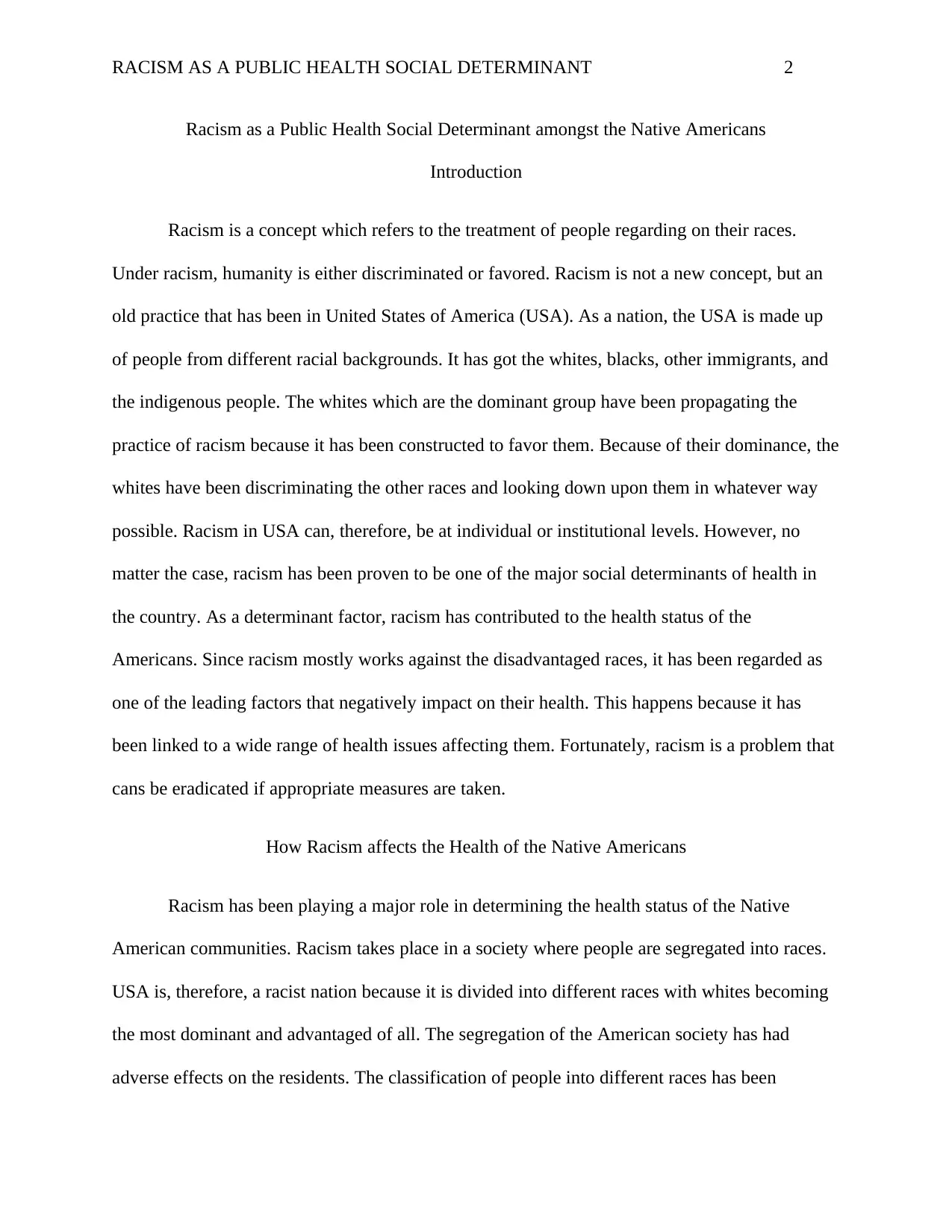
RACISM AS A PUBLIC HEALTH SOCIAL DETERMINANT 2
Racism as a Public Health Social Determinant amongst the Native Americans
Introduction
Racism is a concept which refers to the treatment of people regarding on their races.
Under racism, humanity is either discriminated or favored. Racism is not a new concept, but an
old practice that has been in United States of America (USA). As a nation, the USA is made up
of people from different racial backgrounds. It has got the whites, blacks, other immigrants, and
the indigenous people. The whites which are the dominant group have been propagating the
practice of racism because it has been constructed to favor them. Because of their dominance, the
whites have been discriminating the other races and looking down upon them in whatever way
possible. Racism in USA can, therefore, be at individual or institutional levels. However, no
matter the case, racism has been proven to be one of the major social determinants of health in
the country. As a determinant factor, racism has contributed to the health status of the
Americans. Since racism mostly works against the disadvantaged races, it has been regarded as
one of the leading factors that negatively impact on their health. This happens because it has
been linked to a wide range of health issues affecting them. Fortunately, racism is a problem that
cans be eradicated if appropriate measures are taken.
How Racism affects the Health of the Native Americans
Racism has been playing a major role in determining the health status of the Native
American communities. Racism takes place in a society where people are segregated into races.
USA is, therefore, a racist nation because it is divided into different races with whites becoming
the most dominant and advantaged of all. The segregation of the American society has had
adverse effects on the residents. The classification of people into different races has been
Racism as a Public Health Social Determinant amongst the Native Americans
Introduction
Racism is a concept which refers to the treatment of people regarding on their races.
Under racism, humanity is either discriminated or favored. Racism is not a new concept, but an
old practice that has been in United States of America (USA). As a nation, the USA is made up
of people from different racial backgrounds. It has got the whites, blacks, other immigrants, and
the indigenous people. The whites which are the dominant group have been propagating the
practice of racism because it has been constructed to favor them. Because of their dominance, the
whites have been discriminating the other races and looking down upon them in whatever way
possible. Racism in USA can, therefore, be at individual or institutional levels. However, no
matter the case, racism has been proven to be one of the major social determinants of health in
the country. As a determinant factor, racism has contributed to the health status of the
Americans. Since racism mostly works against the disadvantaged races, it has been regarded as
one of the leading factors that negatively impact on their health. This happens because it has
been linked to a wide range of health issues affecting them. Fortunately, racism is a problem that
cans be eradicated if appropriate measures are taken.
How Racism affects the Health of the Native Americans
Racism has been playing a major role in determining the health status of the Native
American communities. Racism takes place in a society where people are segregated into races.
USA is, therefore, a racist nation because it is divided into different races with whites becoming
the most dominant and advantaged of all. The segregation of the American society has had
adverse effects on the residents. The classification of people into different races has been
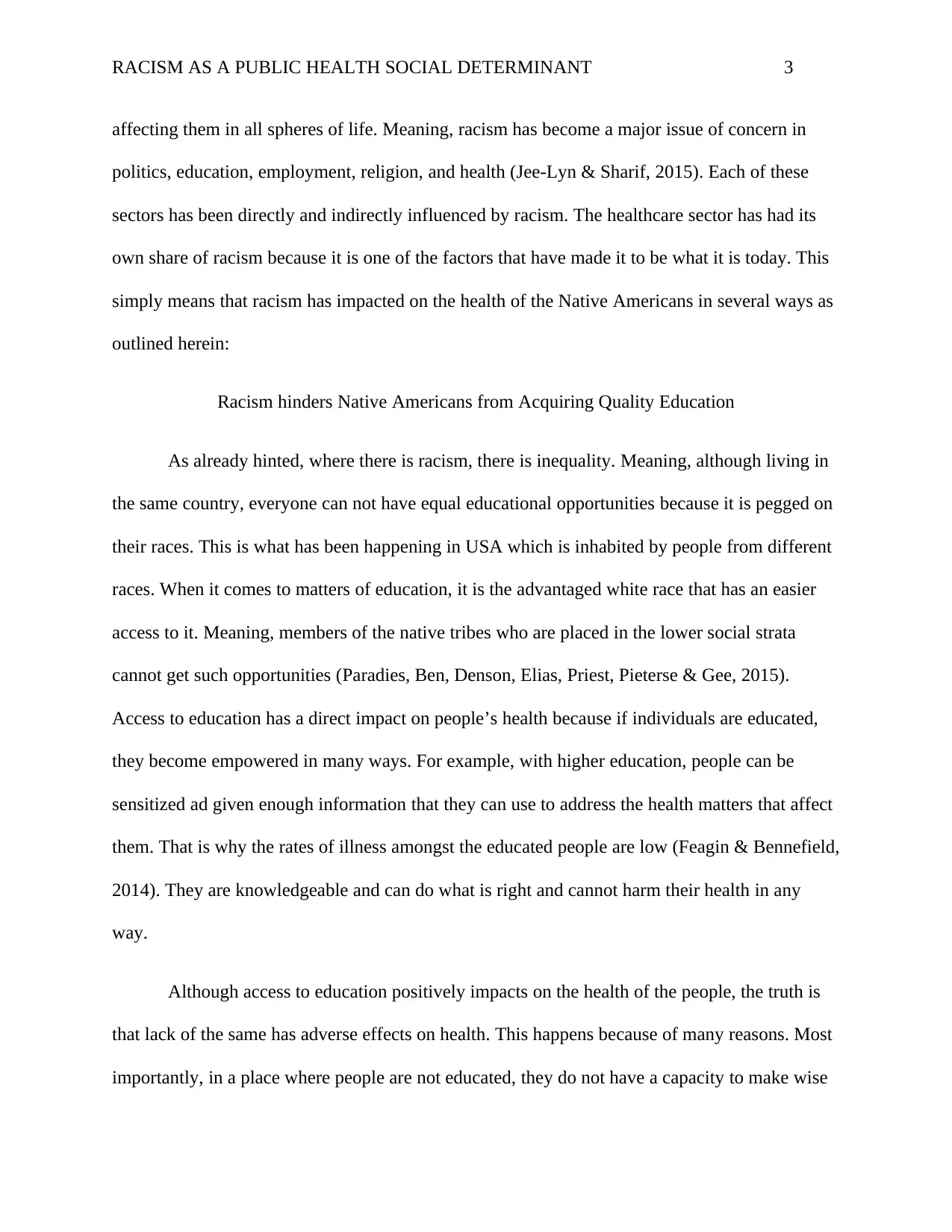
RACISM AS A PUBLIC HEALTH SOCIAL DETERMINANT 3
affecting them in all spheres of life. Meaning, racism has become a major issue of concern in
politics, education, employment, religion, and health (Jee-Lyn & Sharif, 2015). Each of these
sectors has been directly and indirectly influenced by racism. The healthcare sector has had its
own share of racism because it is one of the factors that have made it to be what it is today. This
simply means that racism has impacted on the health of the Native Americans in several ways as
outlined herein:
Racism hinders Native Americans from Acquiring Quality Education
As already hinted, where there is racism, there is inequality. Meaning, although living in
the same country, everyone can not have equal educational opportunities because it is pegged on
their races. This is what has been happening in USA which is inhabited by people from different
races. When it comes to matters of education, it is the advantaged white race that has an easier
access to it. Meaning, members of the native tribes who are placed in the lower social strata
cannot get such opportunities (Paradies, Ben, Denson, Elias, Priest, Pieterse & Gee, 2015).
Access to education has a direct impact on people’s health because if individuals are educated,
they become empowered in many ways. For example, with higher education, people can be
sensitized ad given enough information that they can use to address the health matters that affect
them. That is why the rates of illness amongst the educated people are low (Feagin & Bennefield,
2014). They are knowledgeable and can do what is right and cannot harm their health in any
way.
Although access to education positively impacts on the health of the people, the truth is
that lack of the same has adverse effects on health. This happens because of many reasons. Most
importantly, in a place where people are not educated, they do not have a capacity to make wise
affecting them in all spheres of life. Meaning, racism has become a major issue of concern in
politics, education, employment, religion, and health (Jee-Lyn & Sharif, 2015). Each of these
sectors has been directly and indirectly influenced by racism. The healthcare sector has had its
own share of racism because it is one of the factors that have made it to be what it is today. This
simply means that racism has impacted on the health of the Native Americans in several ways as
outlined herein:
Racism hinders Native Americans from Acquiring Quality Education
As already hinted, where there is racism, there is inequality. Meaning, although living in
the same country, everyone can not have equal educational opportunities because it is pegged on
their races. This is what has been happening in USA which is inhabited by people from different
races. When it comes to matters of education, it is the advantaged white race that has an easier
access to it. Meaning, members of the native tribes who are placed in the lower social strata
cannot get such opportunities (Paradies, Ben, Denson, Elias, Priest, Pieterse & Gee, 2015).
Access to education has a direct impact on people’s health because if individuals are educated,
they become empowered in many ways. For example, with higher education, people can be
sensitized ad given enough information that they can use to address the health matters that affect
them. That is why the rates of illness amongst the educated people are low (Feagin & Bennefield,
2014). They are knowledgeable and can do what is right and cannot harm their health in any
way.
Although access to education positively impacts on the health of the people, the truth is
that lack of the same has adverse effects on health. This happens because of many reasons. Most
importantly, in a place where people are not educated, they do not have a capacity to make wise
⊘ This is a preview!⊘
Do you want full access?
Subscribe today to unlock all pages.

Trusted by 1+ million students worldwide
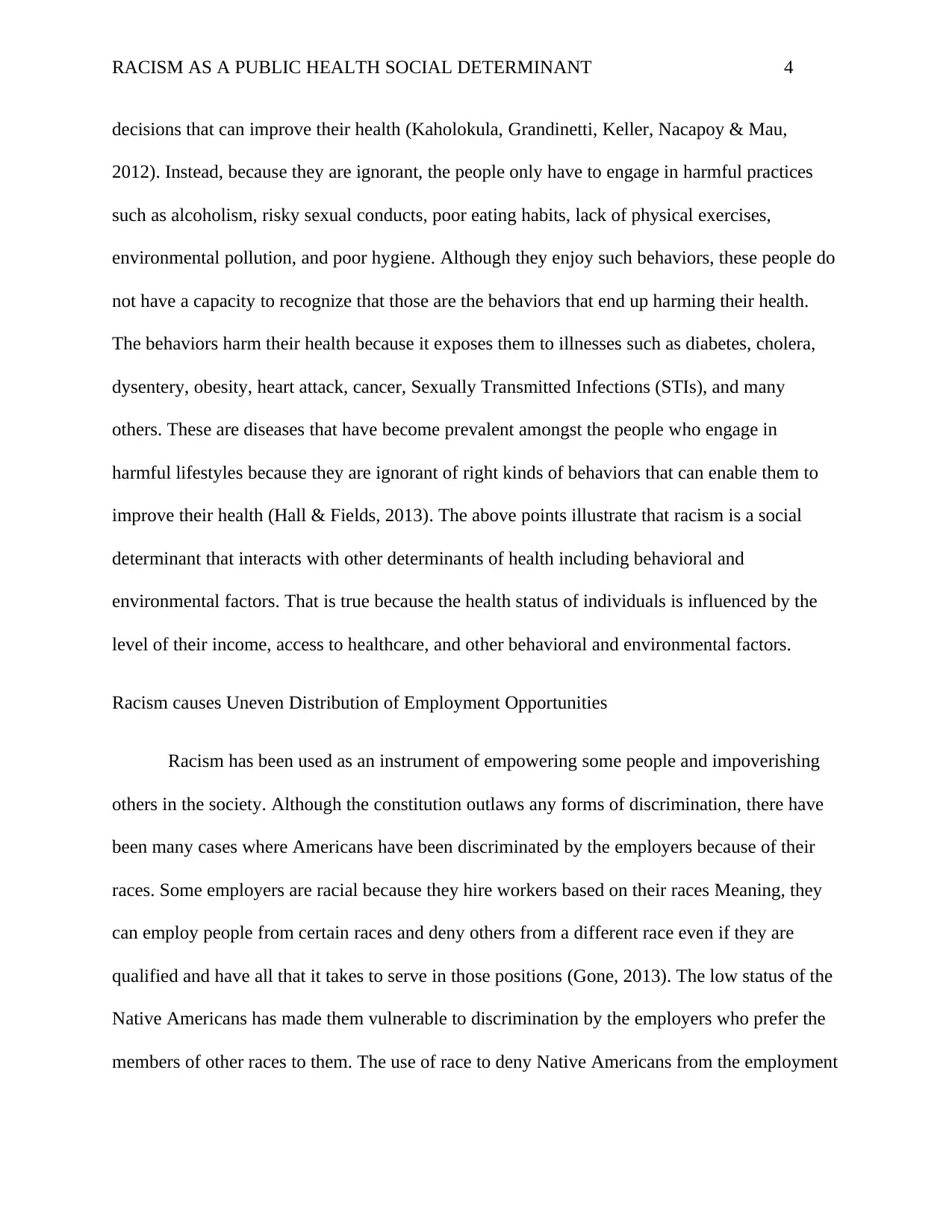
RACISM AS A PUBLIC HEALTH SOCIAL DETERMINANT 4
decisions that can improve their health (Kaholokula, Grandinetti, Keller, Nacapoy & Mau,
2012). Instead, because they are ignorant, the people only have to engage in harmful practices
such as alcoholism, risky sexual conducts, poor eating habits, lack of physical exercises,
environmental pollution, and poor hygiene. Although they enjoy such behaviors, these people do
not have a capacity to recognize that those are the behaviors that end up harming their health.
The behaviors harm their health because it exposes them to illnesses such as diabetes, cholera,
dysentery, obesity, heart attack, cancer, Sexually Transmitted Infections (STIs), and many
others. These are diseases that have become prevalent amongst the people who engage in
harmful lifestyles because they are ignorant of right kinds of behaviors that can enable them to
improve their health (Hall & Fields, 2013). The above points illustrate that racism is a social
determinant that interacts with other determinants of health including behavioral and
environmental factors. That is true because the health status of individuals is influenced by the
level of their income, access to healthcare, and other behavioral and environmental factors.
Racism causes Uneven Distribution of Employment Opportunities
Racism has been used as an instrument of empowering some people and impoverishing
others in the society. Although the constitution outlaws any forms of discrimination, there have
been many cases where Americans have been discriminated by the employers because of their
races. Some employers are racial because they hire workers based on their races Meaning, they
can employ people from certain races and deny others from a different race even if they are
qualified and have all that it takes to serve in those positions (Gone, 2013). The low status of the
Native Americans has made them vulnerable to discrimination by the employers who prefer the
members of other races to them. The use of race to deny Native Americans from the employment
decisions that can improve their health (Kaholokula, Grandinetti, Keller, Nacapoy & Mau,
2012). Instead, because they are ignorant, the people only have to engage in harmful practices
such as alcoholism, risky sexual conducts, poor eating habits, lack of physical exercises,
environmental pollution, and poor hygiene. Although they enjoy such behaviors, these people do
not have a capacity to recognize that those are the behaviors that end up harming their health.
The behaviors harm their health because it exposes them to illnesses such as diabetes, cholera,
dysentery, obesity, heart attack, cancer, Sexually Transmitted Infections (STIs), and many
others. These are diseases that have become prevalent amongst the people who engage in
harmful lifestyles because they are ignorant of right kinds of behaviors that can enable them to
improve their health (Hall & Fields, 2013). The above points illustrate that racism is a social
determinant that interacts with other determinants of health including behavioral and
environmental factors. That is true because the health status of individuals is influenced by the
level of their income, access to healthcare, and other behavioral and environmental factors.
Racism causes Uneven Distribution of Employment Opportunities
Racism has been used as an instrument of empowering some people and impoverishing
others in the society. Although the constitution outlaws any forms of discrimination, there have
been many cases where Americans have been discriminated by the employers because of their
races. Some employers are racial because they hire workers based on their races Meaning, they
can employ people from certain races and deny others from a different race even if they are
qualified and have all that it takes to serve in those positions (Gone, 2013). The low status of the
Native Americans has made them vulnerable to discrimination by the employers who prefer the
members of other races to them. The use of race to deny Native Americans from the employment
Paraphrase This Document
Need a fresh take? Get an instant paraphrase of this document with our AI Paraphraser
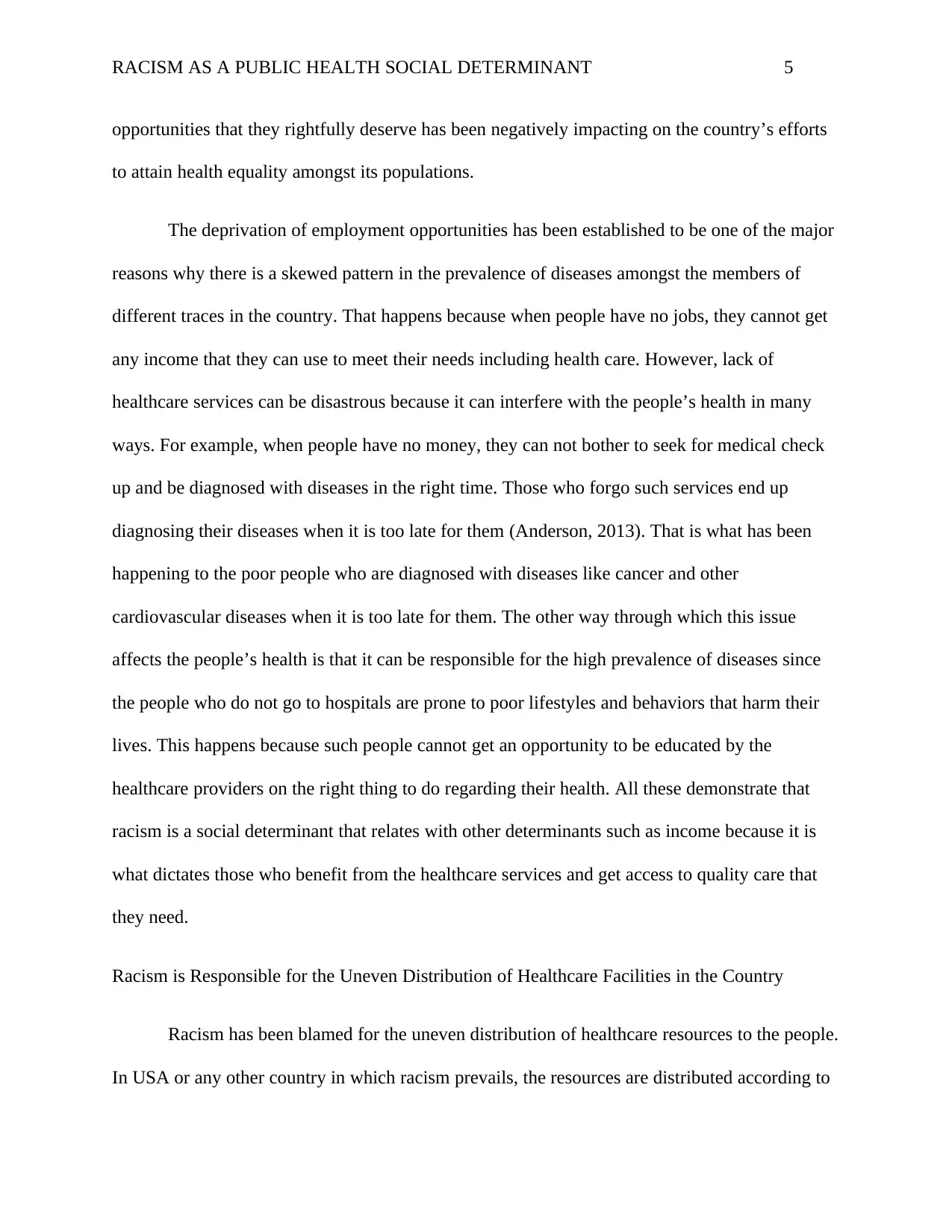
RACISM AS A PUBLIC HEALTH SOCIAL DETERMINANT 5
opportunities that they rightfully deserve has been negatively impacting on the country’s efforts
to attain health equality amongst its populations.
The deprivation of employment opportunities has been established to be one of the major
reasons why there is a skewed pattern in the prevalence of diseases amongst the members of
different traces in the country. That happens because when people have no jobs, they cannot get
any income that they can use to meet their needs including health care. However, lack of
healthcare services can be disastrous because it can interfere with the people’s health in many
ways. For example, when people have no money, they can not bother to seek for medical check
up and be diagnosed with diseases in the right time. Those who forgo such services end up
diagnosing their diseases when it is too late for them (Anderson, 2013). That is what has been
happening to the poor people who are diagnosed with diseases like cancer and other
cardiovascular diseases when it is too late for them. The other way through which this issue
affects the people’s health is that it can be responsible for the high prevalence of diseases since
the people who do not go to hospitals are prone to poor lifestyles and behaviors that harm their
lives. This happens because such people cannot get an opportunity to be educated by the
healthcare providers on the right thing to do regarding their health. All these demonstrate that
racism is a social determinant that relates with other determinants such as income because it is
what dictates those who benefit from the healthcare services and get access to quality care that
they need.
Racism is Responsible for the Uneven Distribution of Healthcare Facilities in the Country
Racism has been blamed for the uneven distribution of healthcare resources to the people.
In USA or any other country in which racism prevails, the resources are distributed according to
opportunities that they rightfully deserve has been negatively impacting on the country’s efforts
to attain health equality amongst its populations.
The deprivation of employment opportunities has been established to be one of the major
reasons why there is a skewed pattern in the prevalence of diseases amongst the members of
different traces in the country. That happens because when people have no jobs, they cannot get
any income that they can use to meet their needs including health care. However, lack of
healthcare services can be disastrous because it can interfere with the people’s health in many
ways. For example, when people have no money, they can not bother to seek for medical check
up and be diagnosed with diseases in the right time. Those who forgo such services end up
diagnosing their diseases when it is too late for them (Anderson, 2013). That is what has been
happening to the poor people who are diagnosed with diseases like cancer and other
cardiovascular diseases when it is too late for them. The other way through which this issue
affects the people’s health is that it can be responsible for the high prevalence of diseases since
the people who do not go to hospitals are prone to poor lifestyles and behaviors that harm their
lives. This happens because such people cannot get an opportunity to be educated by the
healthcare providers on the right thing to do regarding their health. All these demonstrate that
racism is a social determinant that relates with other determinants such as income because it is
what dictates those who benefit from the healthcare services and get access to quality care that
they need.
Racism is Responsible for the Uneven Distribution of Healthcare Facilities in the Country
Racism has been blamed for the uneven distribution of healthcare resources to the people.
In USA or any other country in which racism prevails, the resources are distributed according to
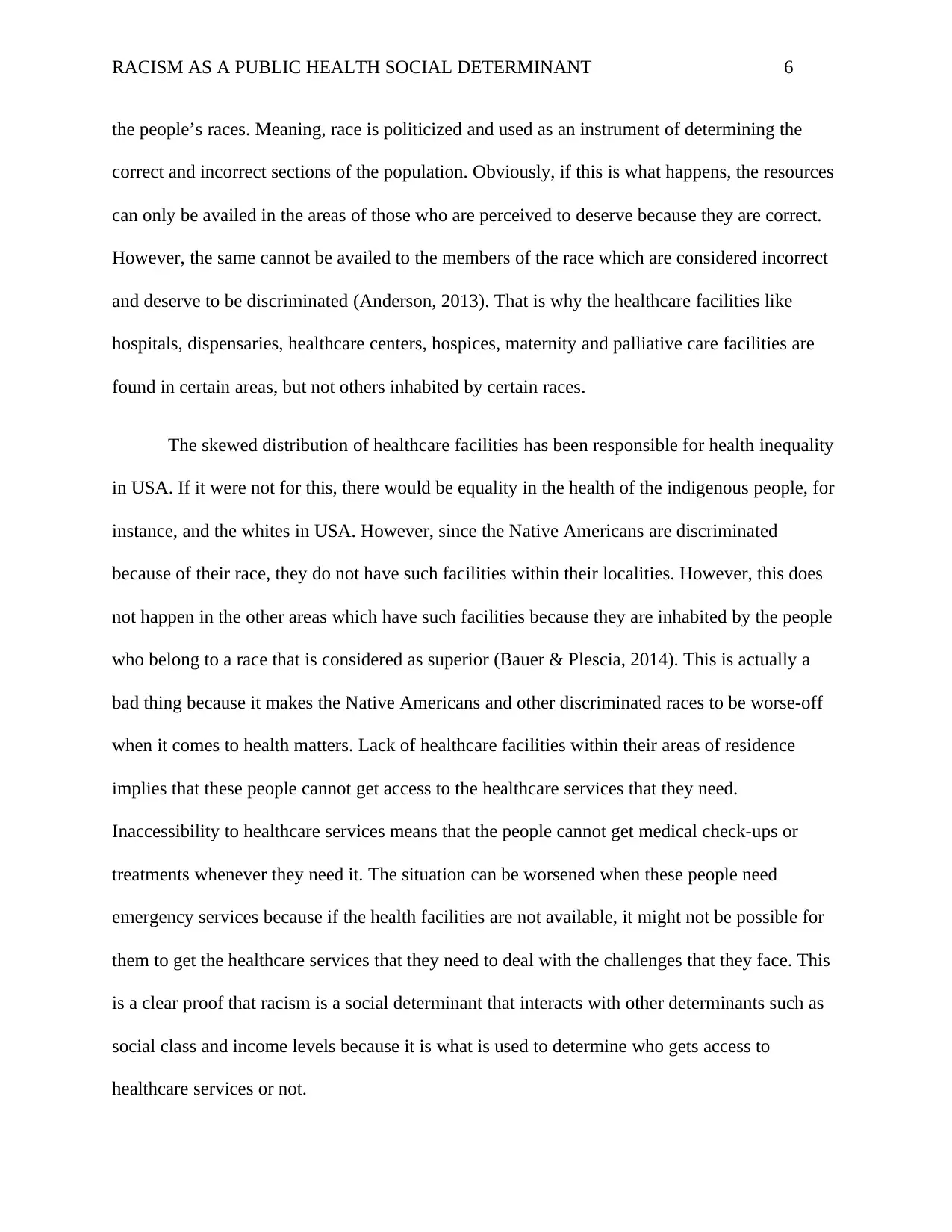
RACISM AS A PUBLIC HEALTH SOCIAL DETERMINANT 6
the people’s races. Meaning, race is politicized and used as an instrument of determining the
correct and incorrect sections of the population. Obviously, if this is what happens, the resources
can only be availed in the areas of those who are perceived to deserve because they are correct.
However, the same cannot be availed to the members of the race which are considered incorrect
and deserve to be discriminated (Anderson, 2013). That is why the healthcare facilities like
hospitals, dispensaries, healthcare centers, hospices, maternity and palliative care facilities are
found in certain areas, but not others inhabited by certain races.
The skewed distribution of healthcare facilities has been responsible for health inequality
in USA. If it were not for this, there would be equality in the health of the indigenous people, for
instance, and the whites in USA. However, since the Native Americans are discriminated
because of their race, they do not have such facilities within their localities. However, this does
not happen in the other areas which have such facilities because they are inhabited by the people
who belong to a race that is considered as superior (Bauer & Plescia, 2014). This is actually a
bad thing because it makes the Native Americans and other discriminated races to be worse-off
when it comes to health matters. Lack of healthcare facilities within their areas of residence
implies that these people cannot get access to the healthcare services that they need.
Inaccessibility to healthcare services means that the people cannot get medical check-ups or
treatments whenever they need it. The situation can be worsened when these people need
emergency services because if the health facilities are not available, it might not be possible for
them to get the healthcare services that they need to deal with the challenges that they face. This
is a clear proof that racism is a social determinant that interacts with other determinants such as
social class and income levels because it is what is used to determine who gets access to
healthcare services or not.
the people’s races. Meaning, race is politicized and used as an instrument of determining the
correct and incorrect sections of the population. Obviously, if this is what happens, the resources
can only be availed in the areas of those who are perceived to deserve because they are correct.
However, the same cannot be availed to the members of the race which are considered incorrect
and deserve to be discriminated (Anderson, 2013). That is why the healthcare facilities like
hospitals, dispensaries, healthcare centers, hospices, maternity and palliative care facilities are
found in certain areas, but not others inhabited by certain races.
The skewed distribution of healthcare facilities has been responsible for health inequality
in USA. If it were not for this, there would be equality in the health of the indigenous people, for
instance, and the whites in USA. However, since the Native Americans are discriminated
because of their race, they do not have such facilities within their localities. However, this does
not happen in the other areas which have such facilities because they are inhabited by the people
who belong to a race that is considered as superior (Bauer & Plescia, 2014). This is actually a
bad thing because it makes the Native Americans and other discriminated races to be worse-off
when it comes to health matters. Lack of healthcare facilities within their areas of residence
implies that these people cannot get access to the healthcare services that they need.
Inaccessibility to healthcare services means that the people cannot get medical check-ups or
treatments whenever they need it. The situation can be worsened when these people need
emergency services because if the health facilities are not available, it might not be possible for
them to get the healthcare services that they need to deal with the challenges that they face. This
is a clear proof that racism is a social determinant that interacts with other determinants such as
social class and income levels because it is what is used to determine who gets access to
healthcare services or not.
⊘ This is a preview!⊘
Do you want full access?
Subscribe today to unlock all pages.

Trusted by 1+ million students worldwide

RACISM AS A PUBLIC HEALTH SOCIAL DETERMINANT 7
The Actions currently being done to address Racism in the Country
Racism is a real threat in USA because it has been causing a lot of agonies to the people.
It is a social issue that has had disastrous effects on the people’s health. From above discussion,
it can be deduced that racism has been one of the leading factors that contribute to the cases of
health inequality in the country. The use of people’s race to determine the distribution of
educational, employment opportunities as well as accessibility to healthcare services has made it
quite challenging for the racially-disadvantaged sections of the society to enjoy better health
(Bauer & Plescia, 2014). However, since racism has been a major issue of concern, it has had to
be fought by taking a number of measures.
First, the government has been coming up with health policies aimed at addressing the
needs of the racially disadvantaged people in USA. As the principal player in the healthcare
sector, the government, through the Department of Health, has been implementing various policy
frameworks aimed at addressing the needs of the Native Americans whose low status has been
depriving them of getting an easy access to quality healthcare services (Pottie, Greenaway,
Feightner, Welch, Swinkels, Rashid & Hassan, 2011). Through such policies, it has become
possible to promote health equality since it does not focus on the advantaged races, but only
concentrates on the disadvantaged because they are considered as a priority group whose health
should be improved at all costs.
Secondly, the government has been making the necessary steps to come up with stringent
legislations to advocate for the elimination of vices like racism and racial discrimination in the
country. For a very long time, many employers have been engaging in racial discrimination
because there have not been strong laws to prevent them from doing so. That is why there have
The Actions currently being done to address Racism in the Country
Racism is a real threat in USA because it has been causing a lot of agonies to the people.
It is a social issue that has had disastrous effects on the people’s health. From above discussion,
it can be deduced that racism has been one of the leading factors that contribute to the cases of
health inequality in the country. The use of people’s race to determine the distribution of
educational, employment opportunities as well as accessibility to healthcare services has made it
quite challenging for the racially-disadvantaged sections of the society to enjoy better health
(Bauer & Plescia, 2014). However, since racism has been a major issue of concern, it has had to
be fought by taking a number of measures.
First, the government has been coming up with health policies aimed at addressing the
needs of the racially disadvantaged people in USA. As the principal player in the healthcare
sector, the government, through the Department of Health, has been implementing various policy
frameworks aimed at addressing the needs of the Native Americans whose low status has been
depriving them of getting an easy access to quality healthcare services (Pottie, Greenaway,
Feightner, Welch, Swinkels, Rashid & Hassan, 2011). Through such policies, it has become
possible to promote health equality since it does not focus on the advantaged races, but only
concentrates on the disadvantaged because they are considered as a priority group whose health
should be improved at all costs.
Secondly, the government has been making the necessary steps to come up with stringent
legislations to advocate for the elimination of vices like racism and racial discrimination in the
country. For a very long time, many employers have been engaging in racial discrimination
because there have not been strong laws to prevent them from doing so. That is why there have
Paraphrase This Document
Need a fresh take? Get an instant paraphrase of this document with our AI Paraphraser
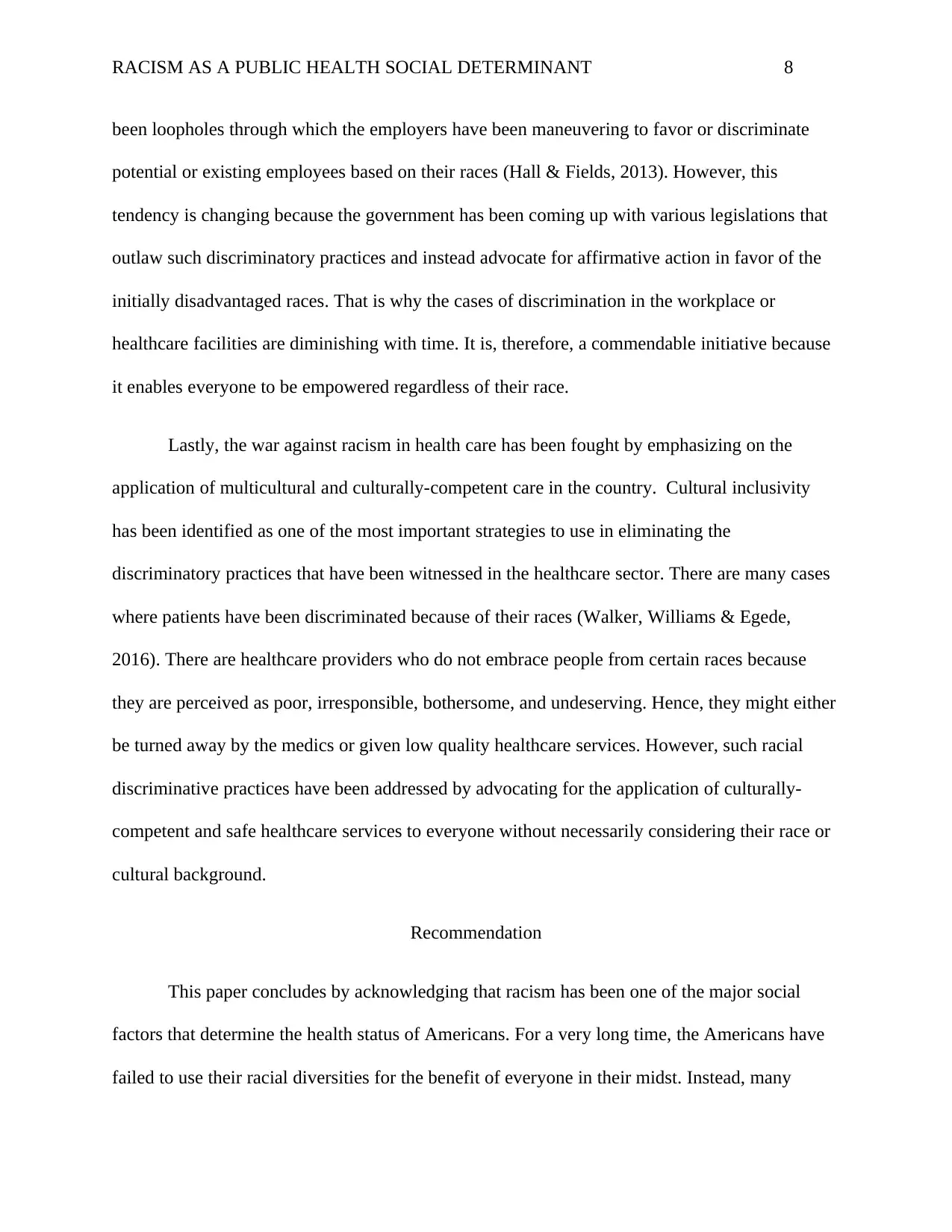
RACISM AS A PUBLIC HEALTH SOCIAL DETERMINANT 8
been loopholes through which the employers have been maneuvering to favor or discriminate
potential or existing employees based on their races (Hall & Fields, 2013). However, this
tendency is changing because the government has been coming up with various legislations that
outlaw such discriminatory practices and instead advocate for affirmative action in favor of the
initially disadvantaged races. That is why the cases of discrimination in the workplace or
healthcare facilities are diminishing with time. It is, therefore, a commendable initiative because
it enables everyone to be empowered regardless of their race.
Lastly, the war against racism in health care has been fought by emphasizing on the
application of multicultural and culturally-competent care in the country. Cultural inclusivity
has been identified as one of the most important strategies to use in eliminating the
discriminatory practices that have been witnessed in the healthcare sector. There are many cases
where patients have been discriminated because of their races (Walker, Williams & Egede,
2016). There are healthcare providers who do not embrace people from certain races because
they are perceived as poor, irresponsible, bothersome, and undeserving. Hence, they might either
be turned away by the medics or given low quality healthcare services. However, such racial
discriminative practices have been addressed by advocating for the application of culturally-
competent and safe healthcare services to everyone without necessarily considering their race or
cultural background.
Recommendation
This paper concludes by acknowledging that racism has been one of the major social
factors that determine the health status of Americans. For a very long time, the Americans have
failed to use their racial diversities for the benefit of everyone in their midst. Instead, many
been loopholes through which the employers have been maneuvering to favor or discriminate
potential or existing employees based on their races (Hall & Fields, 2013). However, this
tendency is changing because the government has been coming up with various legislations that
outlaw such discriminatory practices and instead advocate for affirmative action in favor of the
initially disadvantaged races. That is why the cases of discrimination in the workplace or
healthcare facilities are diminishing with time. It is, therefore, a commendable initiative because
it enables everyone to be empowered regardless of their race.
Lastly, the war against racism in health care has been fought by emphasizing on the
application of multicultural and culturally-competent care in the country. Cultural inclusivity
has been identified as one of the most important strategies to use in eliminating the
discriminatory practices that have been witnessed in the healthcare sector. There are many cases
where patients have been discriminated because of their races (Walker, Williams & Egede,
2016). There are healthcare providers who do not embrace people from certain races because
they are perceived as poor, irresponsible, bothersome, and undeserving. Hence, they might either
be turned away by the medics or given low quality healthcare services. However, such racial
discriminative practices have been addressed by advocating for the application of culturally-
competent and safe healthcare services to everyone without necessarily considering their race or
cultural background.
Recommendation
This paper concludes by acknowledging that racism has been one of the major social
factors that determine the health status of Americans. For a very long time, the Americans have
failed to use their racial diversities for the benefit of everyone in their midst. Instead, many

RACISM AS A PUBLIC HEALTH SOCIAL DETERMINANT 9
people have resorted into racial discrimination because of the feeling that individuals should be
treated based on the type of race in which they belong, That is why the whites who believe that
they are more privileged and superior tend to prejudice and discriminate upon the people from
other races such as the indigenous and immigrants (Williams & Mohammed, 2013). However,
the unfortunate thing is that such discriminatory act have gotten their way into the healthcare
sector in which they determine who becomes health or not. The good news is that such a
situation might be addressed if appropriate measures are taken. Hen e, this paper recommends
the following:
One, the best way to provide an ultimate solution to the problem of racism in health care
is to eradicate the culture of racism in the country. Since racism has been established to be
responsible for the disparities in the health status between the racially correct and incorrect
groups, its elimination can be the surest way of promoting health equality in the country
(Paradies, 2016). Therefore, the best thing to do is to come up with policies to empower
everyone by giving them equal opportunities to education and employment. At the same time,
the government should come up with laws to stringently guard against any form of racial
discrimination in the country. If this is implemented well, no one would dare discriminating upon
anyone because of fear of severe consequences.
Two, the problem of racism in the healthcare sector can be eradicated by coming up with
e health education campaign in the country. The campaign should target two categories of
people-the general public and the healthcare practitioners. The members of the public should be
taught the dangers of racism and the importance of racial inclusivity in their midst. The public
must be sensitized because the acts of racial discrimination, prejudice, and stigmatization that
they have embraced does not mean well for the nation since it only contributes to the poor health
people have resorted into racial discrimination because of the feeling that individuals should be
treated based on the type of race in which they belong, That is why the whites who believe that
they are more privileged and superior tend to prejudice and discriminate upon the people from
other races such as the indigenous and immigrants (Williams & Mohammed, 2013). However,
the unfortunate thing is that such discriminatory act have gotten their way into the healthcare
sector in which they determine who becomes health or not. The good news is that such a
situation might be addressed if appropriate measures are taken. Hen e, this paper recommends
the following:
One, the best way to provide an ultimate solution to the problem of racism in health care
is to eradicate the culture of racism in the country. Since racism has been established to be
responsible for the disparities in the health status between the racially correct and incorrect
groups, its elimination can be the surest way of promoting health equality in the country
(Paradies, 2016). Therefore, the best thing to do is to come up with policies to empower
everyone by giving them equal opportunities to education and employment. At the same time,
the government should come up with laws to stringently guard against any form of racial
discrimination in the country. If this is implemented well, no one would dare discriminating upon
anyone because of fear of severe consequences.
Two, the problem of racism in the healthcare sector can be eradicated by coming up with
e health education campaign in the country. The campaign should target two categories of
people-the general public and the healthcare practitioners. The members of the public should be
taught the dangers of racism and the importance of racial inclusivity in their midst. The public
must be sensitized because the acts of racial discrimination, prejudice, and stigmatization that
they have embraced does not mean well for the nation since it only contributes to the poor health
⊘ This is a preview!⊘
Do you want full access?
Subscribe today to unlock all pages.

Trusted by 1+ million students worldwide

RACISM AS A PUBLIC HEALTH SOCIAL DETERMINANT 10
of the discriminated that become prone to stress, depression, and anxiety when they feel
discriminated in the community where they should belong (Sewell, 2016). On the other hand, the
healthcare providers should be educated and equipped with the skills that they can use to offer
safe and effective culturally-competently care to everyone in the country irrespective of their
racial or cultural background. If these are implemented, racism will never be an impediment in
the America’s healthcare sector.
of the discriminated that become prone to stress, depression, and anxiety when they feel
discriminated in the community where they should belong (Sewell, 2016). On the other hand, the
healthcare providers should be educated and equipped with the skills that they can use to offer
safe and effective culturally-competently care to everyone in the country irrespective of their
racial or cultural background. If these are implemented, racism will never be an impediment in
the America’s healthcare sector.
Paraphrase This Document
Need a fresh take? Get an instant paraphrase of this document with our AI Paraphraser
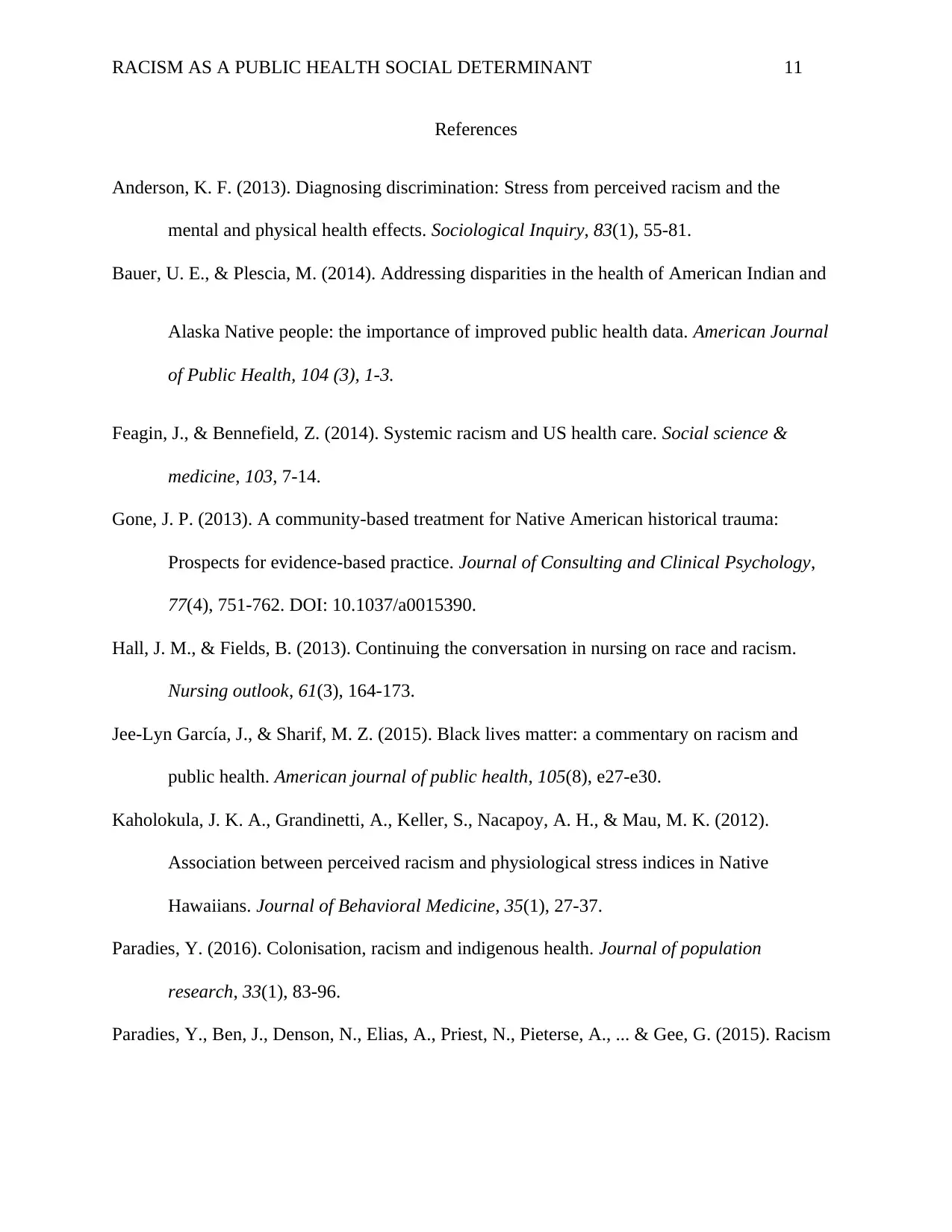
RACISM AS A PUBLIC HEALTH SOCIAL DETERMINANT 11
References
Anderson, K. F. (2013). Diagnosing discrimination: Stress from perceived racism and the
mental and physical health effects. Sociological Inquiry, 83(1), 55-81.
Bauer, U. E., & Plescia, M. (2014). Addressing disparities in the health of American Indian and
Alaska Native people: the importance of improved public health data. American Journal
of Public Health, 104 (3), 1-3.
Feagin, J., & Bennefield, Z. (2014). Systemic racism and US health care. Social science &
medicine, 103, 7-14.
Gone, J. P. (2013). A community-based treatment for Native American historical trauma:
Prospects for evidence-based practice. Journal of Consulting and Clinical Psychology,
77(4), 751-762. DOI: 10.1037/a0015390.
Hall, J. M., & Fields, B. (2013). Continuing the conversation in nursing on race and racism.
Nursing outlook, 61(3), 164-173.
Jee-Lyn García, J., & Sharif, M. Z. (2015). Black lives matter: a commentary on racism and
public health. American journal of public health, 105(8), e27-e30.
Kaholokula, J. K. A., Grandinetti, A., Keller, S., Nacapoy, A. H., & Mau, M. K. (2012).
Association between perceived racism and physiological stress indices in Native
Hawaiians. Journal of Behavioral Medicine, 35(1), 27-37.
Paradies, Y. (2016). Colonisation, racism and indigenous health. Journal of population
research, 33(1), 83-96.
Paradies, Y., Ben, J., Denson, N., Elias, A., Priest, N., Pieterse, A., ... & Gee, G. (2015). Racism
References
Anderson, K. F. (2013). Diagnosing discrimination: Stress from perceived racism and the
mental and physical health effects. Sociological Inquiry, 83(1), 55-81.
Bauer, U. E., & Plescia, M. (2014). Addressing disparities in the health of American Indian and
Alaska Native people: the importance of improved public health data. American Journal
of Public Health, 104 (3), 1-3.
Feagin, J., & Bennefield, Z. (2014). Systemic racism and US health care. Social science &
medicine, 103, 7-14.
Gone, J. P. (2013). A community-based treatment for Native American historical trauma:
Prospects for evidence-based practice. Journal of Consulting and Clinical Psychology,
77(4), 751-762. DOI: 10.1037/a0015390.
Hall, J. M., & Fields, B. (2013). Continuing the conversation in nursing on race and racism.
Nursing outlook, 61(3), 164-173.
Jee-Lyn García, J., & Sharif, M. Z. (2015). Black lives matter: a commentary on racism and
public health. American journal of public health, 105(8), e27-e30.
Kaholokula, J. K. A., Grandinetti, A., Keller, S., Nacapoy, A. H., & Mau, M. K. (2012).
Association between perceived racism and physiological stress indices in Native
Hawaiians. Journal of Behavioral Medicine, 35(1), 27-37.
Paradies, Y. (2016). Colonisation, racism and indigenous health. Journal of population
research, 33(1), 83-96.
Paradies, Y., Ben, J., Denson, N., Elias, A., Priest, N., Pieterse, A., ... & Gee, G. (2015). Racism
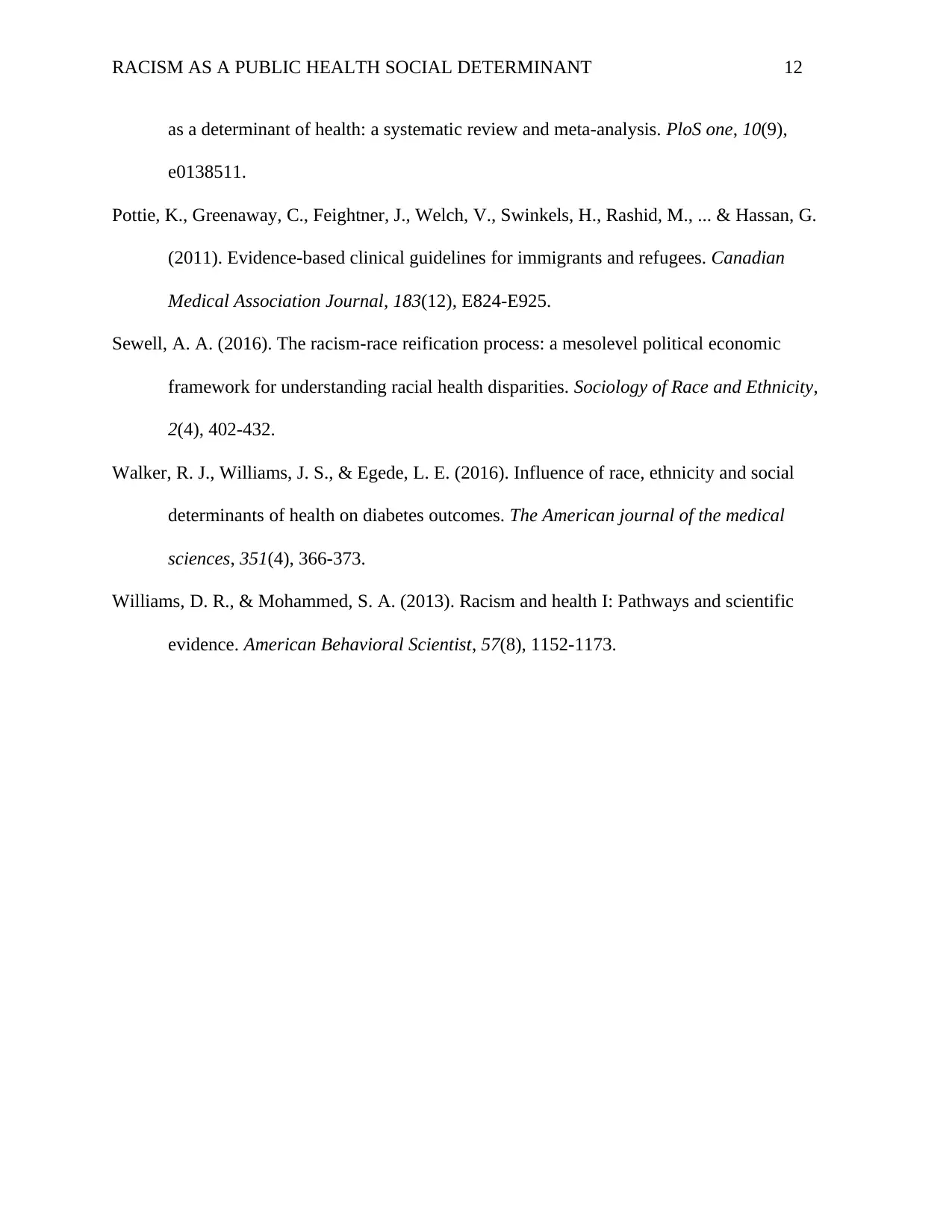
RACISM AS A PUBLIC HEALTH SOCIAL DETERMINANT 12
as a determinant of health: a systematic review and meta-analysis. PloS one, 10(9),
e0138511.
Pottie, K., Greenaway, C., Feightner, J., Welch, V., Swinkels, H., Rashid, M., ... & Hassan, G.
(2011). Evidence-based clinical guidelines for immigrants and refugees. Canadian
Medical Association Journal, 183(12), E824-E925.
Sewell, A. A. (2016). The racism-race reification process: a mesolevel political economic
framework for understanding racial health disparities. Sociology of Race and Ethnicity,
2(4), 402-432.
Walker, R. J., Williams, J. S., & Egede, L. E. (2016). Influence of race, ethnicity and social
determinants of health on diabetes outcomes. The American journal of the medical
sciences, 351(4), 366-373.
Williams, D. R., & Mohammed, S. A. (2013). Racism and health I: Pathways and scientific
evidence. American Behavioral Scientist, 57(8), 1152-1173.
as a determinant of health: a systematic review and meta-analysis. PloS one, 10(9),
e0138511.
Pottie, K., Greenaway, C., Feightner, J., Welch, V., Swinkels, H., Rashid, M., ... & Hassan, G.
(2011). Evidence-based clinical guidelines for immigrants and refugees. Canadian
Medical Association Journal, 183(12), E824-E925.
Sewell, A. A. (2016). The racism-race reification process: a mesolevel political economic
framework for understanding racial health disparities. Sociology of Race and Ethnicity,
2(4), 402-432.
Walker, R. J., Williams, J. S., & Egede, L. E. (2016). Influence of race, ethnicity and social
determinants of health on diabetes outcomes. The American journal of the medical
sciences, 351(4), 366-373.
Williams, D. R., & Mohammed, S. A. (2013). Racism and health I: Pathways and scientific
evidence. American Behavioral Scientist, 57(8), 1152-1173.
⊘ This is a preview!⊘
Do you want full access?
Subscribe today to unlock all pages.

Trusted by 1+ million students worldwide
1 out of 12
Related Documents
Your All-in-One AI-Powered Toolkit for Academic Success.
+13062052269
info@desklib.com
Available 24*7 on WhatsApp / Email
![[object Object]](/_next/static/media/star-bottom.7253800d.svg)
Unlock your academic potential
Copyright © 2020–2025 A2Z Services. All Rights Reserved. Developed and managed by ZUCOL.





